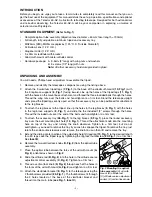
For example, if you are using a 25mm eyepiece, the resulting power will be:
Power = 700mm ÷ 25mm = 28X.
For example, if you are using a 9mm eyepiece, the resulting power will be:
Power = 700mm ÷ 9mm = 78X.
The purpose of a Barlow lens is to increase the magnification possible with a given eyepiece. The 2x
Barlow supplied with this telescope will double the normal eyepiece power. For example, the 25mm
(28X) eyepiece, when used in conjunction with the 2x Barlow lens, yields 56X. The 9mm (78X)
eyepiece yields 156X when used with the 2x Barlow lens.
To use the 2x Barlow lens, insert the 2x Barlow lens into the diagonal mirror (
13, Fig. 1
) followed by
the 25mm eyepiece (
1
,
Fig. 1
). Refocus until the image is sharp.
POWER AND EYEPIECES
The useful higher magnification with any 60mm diameter telescope is in the range of 80 to 120 power.
The general rule to follow with any telescope, regarding power: Only use as much magnification as a
steady, well-defined image supports. The stability of the air varies and is one reason why having
various eyepieces is desirable. Higher powers are no guaranty of better images; in fact, the opposite is
often true.
MAINTENANCE
As with any quality optical instrument, lens surfaces should be cleaned as infrequently as possible. A
little dust on the surface of the objective lens (
14, Fig. 1
) causes negligible degradation of image quality
and should not be considered reason to clean the lens. When lens cleaning does become necessary,
use a camel hair brush or compressed air to gently remove dust. Wipe only with a soft, clean cloth,
applying as little pressure as possible to avoid scratching glass surfaces.
Note:
Gently pull off and
remove the the dew shield/lens shade (
21, Fig. 1
) to access the objective lens (
14, Fig. 1
).
SPECIFICATIONS
Objective (main) lens focal length . . . . . . . . . . .700mm
Objective lens diameter . . . . . . . . . . . . . . . . . . .60mm (2.4")
Focal ratio . . . . . . . . . . . . . . . . . . . . . . . . . . . . . .f/11.7
Mounting type . . . . . . . . . . . . . . . . . . . . . . . . . . .Altazimuth
OPTIONAL ACCESSORIES
#928 45° Erecting Prism (1.25 O.D.):
Correctly orients the telescopic image during terrestrial
observing and yields an image position at a 45° angle to the main telescope tube, resulting in a more
comfortable observing position in most cases.
Additional Eyepieces (1.25" barrel diameter):
For higher or lower magnifications with the telescopes
that accommodate 1.25" eyepieces, Meade 3-element Modified Achromatic eyepieces, available in a
wide variety of sizes, provide a high level of image resolution and color correction at an economical
price. Also, at slightly higher prices, Meade 4-element Series 3000 Plössl eyepieces yield wider fields
of view with excellent edge-of-field corrections and are available in a range of focal lengths including
5, 6.7, 9.5, 16, 25, and 40mm.
70052 04/04








